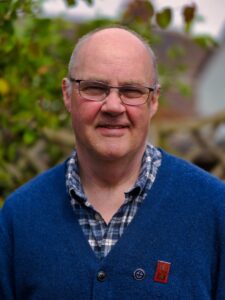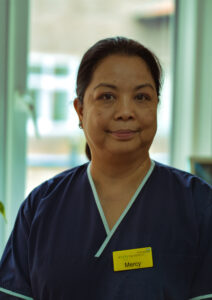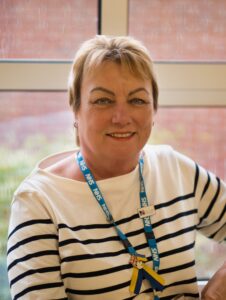Wednesday 14 August 2024
Nursing the Tees Valley Exhibition, open now at Kirkleatham Museum in Redcar, shares the memories and experiences of both retired and current nurses, about what working as a nurse in the Tees Valley is like.
The nurses work or have worked at various NHS Trusts in the region, including Tees, Esk and Wear Valleys NHS Foundation Trust (TEWV), North Tees and Hartlepool NHS Foundation Trust and South Tees Hospitals NHS Foundation Trust.
Over the past year, they have been telling their stories on tape, to provide an oral history that will accompany the various nursing artefacts the museum holds.
Here, we tell the stories of those involved – Steve Harrison, Mercy Cabrega, Paddy Neasham and Teresa Hannaway.
Steve’s story

Steve Harrison’s 45-year career at TEWV began after a chance conversation with his auntie sparked an interest in becoming a mental health nurse.
She had heard about new nursing assistant roles in the NHS and a vacancy working with teenagers. So, at 19 years old, Steve started as a nursing assistant and discovered a lifelong vocation and passion for helping others.
Throughout his career working within children and young people’s mental health, he’s been involved in pioneering community nursing consultant roles and services, national government projects, collaborative work with universities, as well as training the next generation of nursing professionals and family therapists.
He took up his current role as a part-time clinical nurse specialist and a qualified family therapist when he semi-retired in 2015.
Steve says about his profession: “It’s hugely challenging and hugely rewarding. Nursing isn’t just about the tasks that you’re trained to do, it’s about the way you engage with the world and the people in it.
“I’ve had a lot of brilliant role models during my career but as a nurse you’re always in the process of developing and learning. It’s a bit like passing your driving test; you know you can learn to drive, you pass your test, but then you really learn to drive.
“When I look back on my career, I think about relationships. It’s relationships that have helped people move on and make a positive difference in their lives. I think nurses can form relationships in ways that other health professionals might find harder to do. Nurses get alongside people. They don’t tend to sit opposite people.
“However, sometimes the work you do doesn’t blossom until years later. I once worked with someone who had a difficult series of life events and was really unwell. I tried my best and they tried their best, but it didn’t look like we’d got very far.
“Years later I received a letter saying how they had turned their life around. The things that we’d worked on had stayed with them and years later, when they were ready, it had made a big difference.”
Steve is now in his sixties and says he’s coming to the last chapter of his career, which is why he wanted to be involved in the nursing exhibition.
He continued: “I’m still active and I’m still doing new things, so I wanted to tell the story of my privileged time being a mental health nurse. It’s quite an interesting story and I’m happy to tell it for those wanting to listen.”
Mercy’s story

Mercy Cabrega always had her sights set on becoming a nurse – from the very moment someone asked her at five-years-old what she wanted to be when she grew up.
Mercy qualified as a nurse at 21-years-old in the Philippines. After a decade serving her home country, she moved to Teesside in 2003 as part of a national recruitment drive led by North Tees and Hartlepool NHS Foundation Trust.
Now 52-years-old, she has worked her way up the ranks at the University Hospital of North Tees over the last 22 years, all while raising her three children. She is now matron of the hospital’s haematology day unit – a nurse-led service caring for patients with blood-related disorders.
Mercy said: “A nurse might work in paediatrics or in surgery, they might have retired from nursing after decades or just be starting their careers, but we all have one thing in common – that patient care is at the centre of everything we do.
“I work in a specialty where once a patient is diagnosed, they have it for life. When you first meet a patient, they don’t know you – they can be scared, they can be frustrated. As soon as you start seeing them on a regular basis, they open up to you and they can see that actually you’re there for them.
“I know all our patients by their first name. That’s something that’s really important to me, making them feel valued. I come to work each day knowing that I will contribute something beautiful to them – from diagnosis until they die.”
Paddy’s story

When Paddy Neasham followed family tradition to join the NHS, she never thought her training would help casualties of the worst disaster in British sporting history.
Paddy, the daughter of a miner, was born in Shotton Colliery in 1963. After leaving school, she was encouraged by her mother to pursue a career in nursing. She spent the following three years at Winterton Hospital in County Durham, where she trained as a registered mental health nurse.
In the late 1980s, she retrained as a general nurse at a hospital in Sheffield and there she witnessed the aftermath of the Hillsborough disaster.
Almost 100 people lost their lives after a crush of football fans developed during an FA Cup semi-final between Liverpool and Nottingham Forest on 15 April 1989.
“I still remember that day so clearly,” she said. “I was on an early finish and my mam rang me in the afternoon after seeing a news piece on TV. It was absolutely horrific.
“I tried to ring the ward, to see if I was needed, but the switchboard was jammed. I then tried to drive into work but had to turn back because the traffic was so bad.
“I was working on a general surgical ward at the time and, the next day when I was back on duty, we had about 15 patients admitted to the ward with crush injuries. One poor man lost his teenage son.”
Prime Minister Margaret Thatcher and Home Secretary Douglas Hurd both visited Paddy’s ward following the disaster, as did Liverpool manager Kenny Dalglish.
Prince Charles and Princess Diana also paid a visit, with Diana spending her time talking to patients while Charles – now the King – made sure to speak to the staff.
“Charles was lovely to us, but it was an awful time. There were so many harrowing stories, and the patients were traumatized. We just had to do our best,” said Paddy.
Her experience during the Hillsborough disaster forms part of the nursing exhibition at Kirkleatham Museum.
Paddy, who is now a senior supervisor in the mental health crisis team at TEWV, said: “I was delighted to be asked to contribute to the nursing exhibition and help celebrate our precious NHS.
“The NHS is a national treasure – it is a fabulous thing we Brits have. We need to protect it. It’s a vital service. The NHS been a huge part of my life, and my family’s life, and I’ve loved it.”
Teresa’s story

It’s no surprise that Teresa Hannaway was invited to feature in the nursing exhibition. From making history as the youngest Trust employee, to overcoming crippling dyslexia and studying at university, Teresa’s 36-year nursing career at TEWV has been anything but ordinary.
The learning disability nurse left school at 16, disheartened with the education system, and joined a nursing associate Youth Training Scheme (YTS). She had been involved in voluntary work since she was 13 years old and discovered a passion for helping others while volunteering at a play group for children with learning disabilities.
During her YTS, she had a placement at Bankfields Court in Normanby, a respite service for adults with learning disabilities and complex health needs. She enjoyed the “lovely atmosphere, camaraderie and helping to make people’s lives better.”
Teresa continued: “I was offered a job at the end of my YTS. At only 17 years old, I was the youngest person at the Trust to be employed. I spent 18 years at Bankfields Court but couldn’t progress as I didn’t have a degree.
“Luckily, I had a manager who encouraged me and persuaded me to believe in myself. So, at 36 years old I started a nursing diploma at Teesside University. It was during my nursing training that I was officially diagnosed as dyslexic.
“Going back into education for the first time since leaving school was daunting, but I received extra support for my dyslexia and gained more and more confidence in myself.”
Teresa proved it’s never too late to achieve your goals. As well as overcoming dyslexia and studying full-time, she also took on extra shifts through the nursing bank and had a baby just before her final year of study.
After graduating, she continued progressing within the South Tees community nursing team and transforming the lives of people with learning disabilities.
Teresa said: “I took part in the nursing exhibition because of my love of history and to share my story. I’ve experienced lots of changes within the NHS and enjoy working in the community as part of a multi-disciplinary team.
Nursing is very rewarding and there’s a real camaraderie. We all have the same vision to make lives better.”
Kirkleatham Museum is open Tuesday to Sunday 10am to 4.30pm (last entry 4.00pm). Free entry.